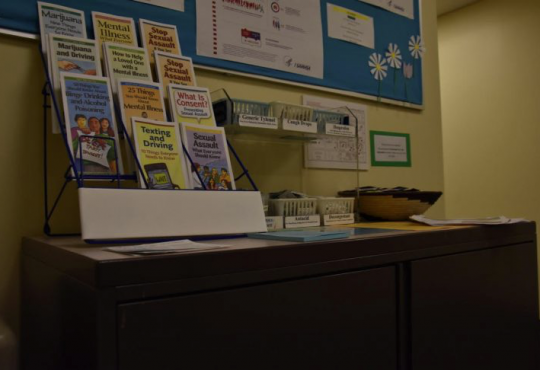Imagine that you’re sick with cold symptoms, and you’ve waited a few days to be seen by health professional in Counseling, Health and Wellness Services (CHWS). You sit in the cramped waiting room alongside other sick students, all of whom have also had to wait for an appointment.You’re in tight quarters among other people coughing and sniffling. After being seen by the nurse or one of the Physician Assistants, you notice several more students in the waiting area and the towering stacks of medical records behind the receptionist’s desk. The space is tiny and the demand clearly exceeds the capacity.
Last week, I spoke with Donn Marshall, the director of CHWS and Associate Dean of Students, and asked how the center is addressing the high volumes of students seeking appointments. Had they ever considered adding more staff members? Being open for longer hours throughout the week, possibly being open on the weekends?
The answer to those questions was yes. The center is currently seeking solutions, but there are limited options, as they are unable to hire any more staff members due to lack of space.
Between three full-time Physician Assistants, a Registered Nurse, a Medical Assistant, three Ph.D. Pyschology staff, three doctoral interns completing their Ph.D., CHWS simply does not have any more office space for additional staff members. Each office is currently occupied, and there is no more square footage available to expand the space.
The need for CHWS’s services is great. According to Marshall, the average wait time for a counseling appointment is 17 days. For medical appointments, students can usually be seen the next day, but the wait can often be longer. CHWS has its day full by 8 a.m. each morning, so its services are entirely maximized.
CHWS has an amazing and hardworking staff, and they do their very best to accommodate the overwhelming need for their services. But they simply do not have enough time in the day to meet with everybody.
This past summer, the University renovated Wheelock, upgrading the kitchens and adding a few more dining options. A new seating area was also added, extending Marshall Hall to an upstairs area, Upper Marshall Hall.
CHWS, a resource used by the vast majority of the student body, was not touched during these renovations. Instead of addressing a pressing student issue such as our health center, the university chose to spend money on its outward appearance by making Wheelock look more spacious and modern.
CHWS is considered an auxiliary service for the University, like Residence Life and Food Service, meaning that its services are not funded through students’ tuition. A representative from each department presents to the Budget Task Force committee every fall to either sunset some of their budget back to the university or justify further needs for the coming year. A department almost never gets all of what it requests.
In addition to the need for more space, CHWS is in desperate need of updating. It is in the process of shifting from paper record keeping to electronic medical records, and the computers often crash, causing the schedules and records to become lost entirely or jumbled.
Upper Marshall Hall is a beautiful space, plenty large enough to host substantial groups of people—perfect for admission to use for its Admitted Students Days or their new Discover Puget Sound events this past fall.
But, as far as the benefits to the current student body, there aren’t many. The additional upstairs space is nearly empty during meal times, and people seem to prefer the immediate, more intimate seating area downstairs in Marshall Hall.
There are several other large event spaces on campus—Trimble Forum, the Tahoma Room in Commencement Hall, the Rotunda in Wheelock—yet the University decided we still needed another venue. Sure, once a space is built, people and organizations will find use for it, but was it really necessary? Was the money we spent on Upper Marshall Hall maximized for student benefit?
Instead of building Upper Marshall Hall, we should have spent the money updating or renovating CHWS. Over the course of the academic year, CHWS will see about 70 percent of the student body for one of their services. Of that, about 15-17 percent has a counseling appointment. The daily walk-in hours from 1 to 3 p.m. are almost always full, and students with urgent needs are often forced to go elsewhere because they cannot wait almost three weeks to talk to somebody.
Marshall researched the average wait time for an appointment at five different private practices in the Tacoma area, and the results ranged from 3-17 days. CHWS is at the extreme long end of the spectrum, and the problem must be addressed.
Marshall sees “no way to hire out of the problem” because as CHWS provides more services, students will take advantage of them. This is not necessarily a bad thing, as Marshall argues, because in the past ten years or so, “the stigma about seeking counseling has declined” and people are educated at a younger age about the importance of being mentally and emotionally healthy.
As an alternative to expanding CHWS on campus, I propose to increase its fluidity with off-campus care. What if CHWS provided an on-call shuttle that brought students to and from urgent care or counseling visits, should they have an issue that could not be treated on campus, or were unable to get an appointment in a timely manner?
CHWS already reimburses taxi fares to and from urgent care, but I’m proposing a more rigid system. Perhaps an ASUPS van be reserved for medical visits, or CHWS gets its own van to create this service.
While the shuttle service would surely cost a significant amount of money, the benefits would be realized in the overall health of our student body, both physically and emotionally.
Instead of waiting an average of 17 days for a counseling appointment, students could meet with regional small private practices in less than a quarter of the wait time.
I would like the University to prioritize its renovations toward services that benefit current students rather than our outward appearance. It’s far more marketable to claim that we have happy and healthy students than to show off a new renovation.




